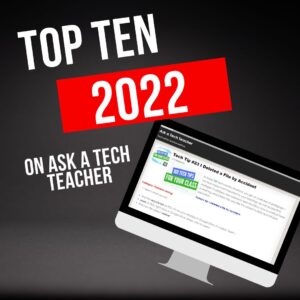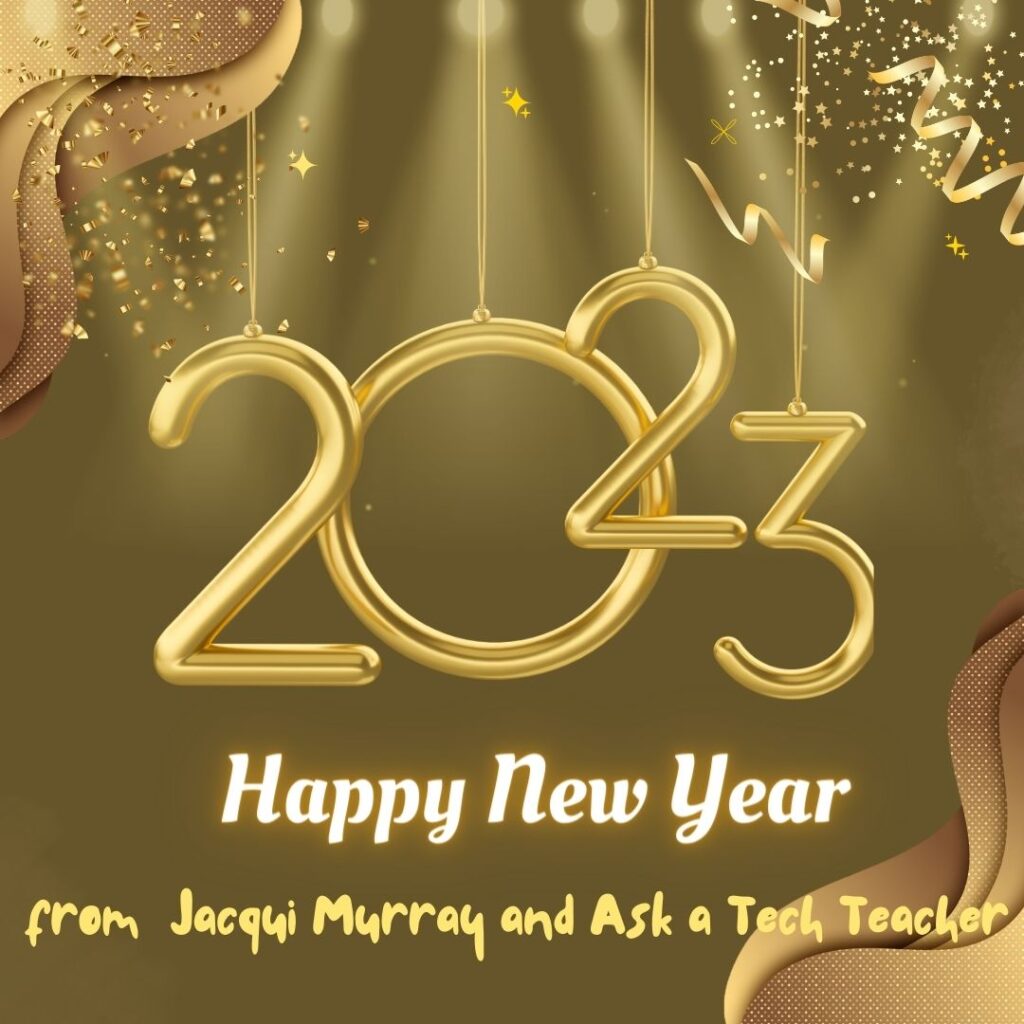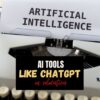Author: Jacqui
Top Ten for 2022

Since we at Ask a Tech Teacher started this blog fourteen years ago, we’ve had almost 5.9 million views, about 10,000 followers who read some or all of our 2,931 articles on integrating technology into the classroom. This includes tech tips, website/app reviews, tech-in-ed pedagogy, how-tos, videos, and more. We have regular features like:
If you’ve just arrived at Ask a Tech Teacher, start here.
It always surprises us what readers find to be the most and least provocative topics. The latter is as likely to be a post one of us on the crew put heart and soul into, sure we were sharing Very Important Information, as the former. Talk about humility.
Here they are–my top 10 lists for 2022:
Share this:
- Click to share on Facebook (Opens in new window) Facebook
- Click to share on X (Opens in new window) X
- Click to share on LinkedIn (Opens in new window) LinkedIn
- Click to share on Pinterest (Opens in new window) Pinterest
- Click to share on Telegram (Opens in new window) Telegram
- Click to email a link to a friend (Opens in new window) Email
- More
Public Domain Day and Happy New Year!
Every year, January 1st is Public Domain Day. This is an observance of when copyrights expire and works enter into the public domain–free for all to use. According to Public Domain Review, here are some of the newly-available artistic works you might like a/o January 1, 2023:
The picture above is interactive. If you click it, you enter Public Domain Review’s website and can then explore each of these new sources of inspiration, free to use.
One that caught my attention is Winnie the Pooh, now in the public domain. Knowing that, I should feel comfortable posting his picture: (more…)
Share this:
- Click to share on Facebook (Opens in new window) Facebook
- Click to share on X (Opens in new window) X
- Click to share on LinkedIn (Opens in new window) LinkedIn
- Click to share on Pinterest (Opens in new window) Pinterest
- Click to share on Telegram (Opens in new window) Telegram
- Click to email a link to a friend (Opens in new window) Email
- More
Happy New Year!
Share this:
- Click to share on Facebook (Opens in new window) Facebook
- Click to share on X (Opens in new window) X
- Click to share on LinkedIn (Opens in new window) LinkedIn
- Click to share on Pinterest (Opens in new window) Pinterest
- Click to share on Telegram (Opens in new window) Telegram
- Click to email a link to a friend (Opens in new window) Email
- More
A New Approach to Learning Through ChatGPT, AI Tools
In case you are not familiar with neural networks or have not used AI-based tools, you will be surprised to learn that solutions like ChatGPT tend to use the principles of transformer architecture. The core idea is an analysis of the lengthy bits of text where the system analyzes the keywords and sequences used to create a natural language flow. It also makes learning through ChatGPT and similar tools suitable for learning purposes and even works with autistic and dyslexic students who require more profound assistance with memorization, spelling, and pronunciation training. What makes it truly different is the level of customization and flexibility that becomes possible with the latest version builds.
Ask a Tech Teacher contributor, Jodi Williams, discusses:
A New Approach to Learning Through AI Tools
- New Approach to Customer Assistance.
Although the use of Chat GPT and similar offerings are best known for their use as an intelligent chatbot implementation, it is way more than that! It is also a great way to learn about the demands of the customers, keep track of things, and keep them engaged while you seek information or choose the best products by looking through the database. The most important is to input correct information and keep things at a conversational level. If you want to explore things deeper, consider custom research paper writing help and see what phrases and linguistic constructions will work best for your needs.
Share this:
- Click to share on Facebook (Opens in new window) Facebook
- Click to share on X (Opens in new window) X
- Click to share on LinkedIn (Opens in new window) LinkedIn
- Click to share on Pinterest (Opens in new window) Pinterest
- Click to share on Telegram (Opens in new window) Telegram
- Click to email a link to a friend (Opens in new window) Email
- More
Learning a New Language Online: How It Can Help Your Child
When your child comes up with an idea of learning a new language, one of the best ways to achieve success is to learn online and keep things as peaceful and interactive as you possibly can. Since most children, these days are used to electronic gadgets and spend their time busy on social media, learning a language with the help of a reliable app and online courses is always efficient. Since your child does not have to visit a language school or spend time elsewhere, the learning sessions online can be adjusted to the school schedule and extended beyond the study hours for practicing purposes. It helps to achieve peace of mind for the parents and adds a healthy degree of interaction to keep the child inspired.
Ask a Tech Teacher contributor, Jodi Williams, linguist and educator, has five tips on learning a new language if you are doing so online:
Learning a New Language Online: How it Can Help Your Child
Learn According to Your Schedule.
The most important benefit of online learning is that you can create a special schedule where grammar and writing tasks are kept in balance according to the child’s progress and skills. You don’t have to start with the typical textbooks or follow the complex objectives of the language learning course if something doesn’t work. Since we are dealing with a child, teachers can provide games and quizzes as long as the technology is accessible. Now, suppose you are a college student working on the peculiarities of online language learning. In that case, you can use the experience with a younger sibling or a child of your own by exploring the subject. In case you are feeling stuck, consider college essays for sale, as it’s one of the safest ways to get things done and structure your thoughts correctly! (more…)
Share this:
- Click to share on Facebook (Opens in new window) Facebook
- Click to share on X (Opens in new window) X
- Click to share on LinkedIn (Opens in new window) LinkedIn
- Click to share on Pinterest (Opens in new window) Pinterest
- Click to share on Telegram (Opens in new window) Telegram
- Click to email a link to a friend (Opens in new window) Email
- More
Have Santa Call Your Kids!
 DialMyCalls (an AATT sponsor) has a special Christmas offer for kids:
DialMyCalls (an AATT sponsor) has a special Christmas offer for kids:
Free Santa Calls To Your Family This Christmas
This Christmas we have a great gift for everyone! Whether you’re an existing DialMyCalls user or not, you can take advantage of our completely free phone call from Santa. Imagine the look on your child’s face when they receive a personalized phone call from Santa with his or her name on it!
- Simply select your child’s name and the message from Santa you want sent on this link.
- Pick the time, date and phone number you want the call sent to.
- We create a personalized message and send the call when you want it sent!
- Each household can send up to 3 free calls from Santa Claus.
- Additional Santa Calls may be purchased for a small fee.
What an amazing gift to any child for Christmas!
@DialMyCalls
Share this:
- Click to share on Facebook (Opens in new window) Facebook
- Click to share on X (Opens in new window) X
- Click to share on LinkedIn (Opens in new window) LinkedIn
- Click to share on Pinterest (Opens in new window) Pinterest
- Click to share on Telegram (Opens in new window) Telegram
- Click to email a link to a friend (Opens in new window) Email
- More
How to Backup and Image Your Computer

This week, I’ll post updated suggestions to get your computers and technology ready for the blitz of projects you’ll swear to accomplish in New Year resolutions. Here’s what you’ll get (links won’t be active until the post goes live):
- 8+ Ways to Speed Up Your Computer — December 13th
- 9 Ways to Update Your Online Presence — December 14th
- Backup and Image your computer — December 15th
Regular readers of Ask a Tech Teacher know these are updated each December. New readers: Consider these body armor in the tech battle so you can jubilantly overcome rather than dramatically succumb.

Today: Image and Backup Your Computer
Two maintenance tasks lots of people skip are:
-
- back up your documents
-
- image your computer
Backup Data Files

Every teacher I know has lost critical work because they didn’t back up on a regular basis. There’s no reason for that. Backing up is easy, fairly quick, and usually free. For details on backing up your computer, check out LifeHacker, PC World, and Windows online help.
A reminder from Janet over at Focused on Story:
“…check your external hard drive to make sure it actually has the computer backed up files on it. Unfortunately we backed up to it, but all of the files weren’t getting backed up. We’d had the back-up a long time, so when the tech checked it, he heard something rattling inside. It was broken! sigh.”
Yep–I had that happen once, too!
Another suggestion from Andrew over at Andrew’s View of the Week:
“On a Mac, use an external USB drive and time machine to backup and consider using iCloud for remote backups.”
Image your computer (more…)
Share this:
- Click to share on Facebook (Opens in new window) Facebook
- Click to share on X (Opens in new window) X
- Click to share on LinkedIn (Opens in new window) LinkedIn
- Click to share on Pinterest (Opens in new window) Pinterest
- Click to share on Telegram (Opens in new window) Telegram
- Click to email a link to a friend (Opens in new window) Email
- More
9 Ways to Update Your Online Presence

This week, I’ll post updated suggestions to get your computers and technology ready for the blitz of projects you’ll swear to accomplish in New Year resolutions. Here’s what you’ll get (links won’t be active until the post goes live):
- 8+ Ways to Speed Up Your Computer — December 13th
- 9 Ways to Update Your Online Presence — December 14th
- Backup and Image your computer — December 15th
Regular readers of Ask a Tech Teacher know these are updated each December. New readers: Consider these body armor in the tech battle so you can jubilantly overcome rather than dramatically succumb.

9 Ways to Update Your Online Presence
For most teachers I know, life zooms by, filled with students, parents, meetings, grading, and thinking. There are few breaks to update/fix/maintain the tech tools that allow us to pursue our trade.
That includes your online presence and all those personal profiles. But, that must happen or they no longer accomplish what we need. If they aren’t updated, we are left wondering why our blog isn’t getting visitors, why our social media Tweeple don’t generate activity, and why we aren’t being contacted for networking. Here’s a short list of items that won’t take long to accomplish:
Share this:
- Click to share on Facebook (Opens in new window) Facebook
- Click to share on X (Opens in new window) X
- Click to share on LinkedIn (Opens in new window) LinkedIn
- Click to share on Pinterest (Opens in new window) Pinterest
- Click to share on Telegram (Opens in new window) Telegram
- Click to email a link to a friend (Opens in new window) Email
- More
8+ Steps To A Speedier Computer

This week, I’ll post updated suggestions to get your computers and technology ready for the blitz of projects you’ll swear to accomplish in New Year resolutions. Here’s what you’ll get (links won’t be active until the post goes live):
- 8+ Ways to Speed Up Your Computer — December 13th
- 9 Ways to Update Your Online Presence — December 14th
- Backup and Image your computer — December 15th
Regular readers of Ask a Tech Teacher know these are updated each December. New readers: Consider these body armor in the tech battle so you can jubilantly overcome rather than dramatically succumb.

Today: 8 Ways to Speed up Your Computer
Share this:
- Click to share on Facebook (Opens in new window) Facebook
- Click to share on X (Opens in new window) X
- Click to share on LinkedIn (Opens in new window) LinkedIn
- Click to share on Pinterest (Opens in new window) Pinterest
- Click to share on Telegram (Opens in new window) Telegram
- Click to email a link to a friend (Opens in new window) Email
- More
Exploring the Need for Education Consultants in a Digital World
Education has become a lot more complicated the last five years. Part of that is the impact of COVID on in-person and remote teaching. Another large part is the transparency now requested/required by parents as to what is going on in the classroom. The importance of education consultants, mentors, and teacher coaches has never been more pressing. Here’s a good article from the Ask a Tech Teacher crew on what that means and how you as an educator can confront the issues:
Exploring the Need for Education Consultants in a Digital World
There is no denying that we live in a vastly different world than we did just three years ago. Just as an increasing number of businesses have moved their operations totally online, so too have many students moved to online programs for their educational needs. All grade levels are now seeing an increase in the number of students who study online since the recent pandemic forced them to do so. Even though classrooms are once again open to student enrolment, many parents have opted to keep their children at home where they feel safer for a number of reasons.
A Myriad of Reasons for Online Education
Sadly, it isn’t only fear of contagions that has prompted this but also other factors such as the rising level of violence and bullying in schools, the fear of school shootings and various factors within family life. Parents who often struggled to get kids to and from school because of work hours, can now find ways to adjust everyone’s schedule so that no one needs to be late or miss days due to conflicts that occur far too often. Some parents simply like to monitor what their kids are learning and how they are being taught.
Share this:
- Click to share on Facebook (Opens in new window) Facebook
- Click to share on X (Opens in new window) X
- Click to share on LinkedIn (Opens in new window) LinkedIn
- Click to share on Pinterest (Opens in new window) Pinterest
- Click to share on Telegram (Opens in new window) Telegram
- Click to email a link to a friend (Opens in new window) Email
- More














































